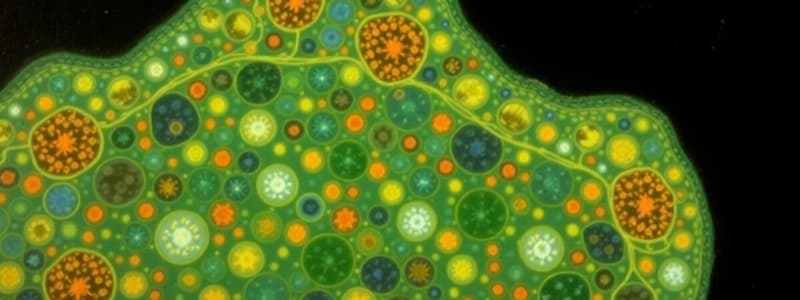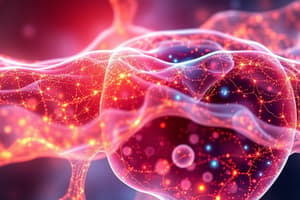Podcast
Questions and Answers
What characteristic of membrane structure explains why membranes are considered fluid?
What characteristic of membrane structure explains why membranes are considered fluid?
- The consistent orientation of glycolipids
- The dynamic arrangement of phospholipids and proteins (correct)
- The complete impermeability to all substances
- The presence of rigid cholesterol molecules
Which statement best describes the structure of phospholipids in biological membranes?
Which statement best describes the structure of phospholipids in biological membranes?
- They contain saturated fatty acids exclusively.
- They are uniformly distributed throughout the membrane.
- They form a bilayer with hydrophilic heads facing inward. (correct)
- They have polar hydrophobic tails and non-polar hydrophilic heads.
What role do glycolipids play in cellular membranes?
What role do glycolipids play in cellular membranes?
- They facilitate active transport of ions.
- They provide recognition sites on the cell surface. (correct)
- They primarily act as passive structural components.
- They generate energy for cellular processes.
How do sterols, such as cholesterol, affect the properties of cell membranes?
How do sterols, such as cholesterol, affect the properties of cell membranes?
Which feature distinguishes the asymmetrical distribution of membrane lipids within the bilayer?
Which feature distinguishes the asymmetrical distribution of membrane lipids within the bilayer?
What is the effect of trans-unsaturated fatty acids on membrane fluidity?
What is the effect of trans-unsaturated fatty acids on membrane fluidity?
Which type of proteins are embedded within the lipid bilayer and have hydrophobic segments?
Which type of proteins are embedded within the lipid bilayer and have hydrophobic segments?
How do cholesterol molecules influence membrane fluidity?
How do cholesterol molecules influence membrane fluidity?
What describes the structure of glycolipids in the membrane?
What describes the structure of glycolipids in the membrane?
What is one of the primary roles of the sodium pump in maintaining cell membrane potential?
What is one of the primary roles of the sodium pump in maintaining cell membrane potential?
How are the lipids distributed asymmetrically in the membrane?
How are the lipids distributed asymmetrically in the membrane?
What is one characteristic feature of peripheral proteins in the plasma membrane?
What is one characteristic feature of peripheral proteins in the plasma membrane?
Which of the following statements about cis-unsaturated fatty acids is true?
Which of the following statements about cis-unsaturated fatty acids is true?
Which characteristic most significantly impacts the fluidity of the plasma membrane?
Which characteristic most significantly impacts the fluidity of the plasma membrane?
What defines the asymmetrical distribution of membrane lipids?
What defines the asymmetrical distribution of membrane lipids?
Which of the following lipid types contributes approximately 5-10% of total plasma membrane lipids?
Which of the following lipid types contributes approximately 5-10% of total plasma membrane lipids?
What role does cholesterol play in the plasma membrane's properties?
What role does cholesterol play in the plasma membrane's properties?
Which type of fatty acid configuration increases the fluidity of the plasma membrane?
Which type of fatty acid configuration increases the fluidity of the plasma membrane?
What is typically found in the structure of phospholipids that contribute to their amphiphilic nature?
What is typically found in the structure of phospholipids that contribute to their amphiphilic nature?
Which type of phospholipid is most commonly found in plasma membranes?
Which type of phospholipid is most commonly found in plasma membranes?
Which factor primarily helps phospholipid molecules maintain their arrangement in a membrane?
Which factor primarily helps phospholipid molecules maintain their arrangement in a membrane?
Glycolipids are primarily known for their role in which of the following?
Glycolipids are primarily known for their role in which of the following?
Which statement regarding the flip-flop movement of phospholipids is accurate?
Which statement regarding the flip-flop movement of phospholipids is accurate?
How do cis-double bonds in fatty acids affect membrane fluidity?
How do cis-double bonds in fatty acids affect membrane fluidity?
What describes the structure of sphingolipids in comparison to phospholipids?
What describes the structure of sphingolipids in comparison to phospholipids?
The movement of phospholipids during lateral diffusion occurs between which specific layers?
The movement of phospholipids during lateral diffusion occurs between which specific layers?
The fluid mosaic model emphasizes the dynamic nature of which component of the cell?
The fluid mosaic model emphasizes the dynamic nature of which component of the cell?
What is the primary purpose of the cell cycle in eukaryotic cells?
What is the primary purpose of the cell cycle in eukaryotic cells?
Which statement best describes apoptosis in relation to cell division?
Which statement best describes apoptosis in relation to cell division?
What is the consequence of uncontrolled cell division leading to dysplasia?
What is the consequence of uncontrolled cell division leading to dysplasia?
What is the role of 'suicide genes' in cell division?
What is the role of 'suicide genes' in cell division?
Why is it important to maintain a balance between cell division and cell death?
Why is it important to maintain a balance between cell division and cell death?
What is hyperplasia primarily characterized by?
What is hyperplasia primarily characterized by?
During which phase of the cell cycle does DNA replication occur?
During which phase of the cell cycle does DNA replication occur?
What is the main purpose of the G1 phase in the cell cycle?
What is the main purpose of the G1 phase in the cell cycle?
How long does the G2 phase typically last in the cell cycle?
How long does the G2 phase typically last in the cell cycle?
Which statement best describes karyokinesis?
Which statement best describes karyokinesis?
What occurs during the G0 phase in cells such as neurons?
What occurs during the G0 phase in cells such as neurons?
Which phase is characterized by the completion of centriole replication?
Which phase is characterized by the completion of centriole replication?
During the mitotic phase, what process occurs after karyokinesis?
During the mitotic phase, what process occurs after karyokinesis?
Flashcards are hidden until you start studying
Study Notes
Plasma Membrane Functions
- Acts as a barrier between the cell's interior and the external environment
- Regulates the movement of ions, nutrients, and other small molecules into and out of the cell
- Facilitates cell-cell interactions and cell signaling through receptors
- Serves as a site for metabolic activities
- Contributes to cell shape
The Fluid Mosaic Model
- The plasma membrane's structure is described by the "Fluid Mosaic Model", proposed by Singer and Nicolson, which emphasizes the dynamic and fluid nature of the membrane.
Existing Evidence for the Plasma Membrane
- Before the development of electron microscopy in the 1950s, the existence of the plasma membrane was not directly observed.
- Early researchers relied on indirect evidence to postulate the presence of a barrier surrounding cells.
Chronology of Membrane Studies
- Overton (1890s): Identified the lipid nature of the membrane.
- Langmuir (1900s): Demonstrated the formation of lipid monolayers.
- Gorter and Grendel (1920s): Proposed the lipid bilayer model.
- Davson and Danielli (1940s): Refined the model to include protein sheets on either side of the lipid bilayer.
- Robertson (1960s): Using electron microscopy, described the unit membrane featuring a trilaminar structure.
- Singer and Nicolson (1970-80s): Introduced the Fluid Mosaic Model.
- 1980s-2000s: Advancements in technology allowed for the elucidation of membrane protein structures, specifically the alpha helix transmembrane domains.
Structure of the Plasma Membrane: Lipid Molecules
- Lipid molecules constitute about 50% of the mass of most animal cell membranes.
- They exhibit an asymmetrical distribution within the membrane.
- They are amphiphilic, containing both hydrophilic (water-loving) and hydrophobic (water-fearing) regions.
- The hydrophilic head is polar, and the hydrophobic tail is nonpolar.
Types of Membrane Lipids
- Phospholipids:
- Contain two hydrocarbon tails.
- The tails vary in length (14-24 carbon atoms).
- They spontaneously aggregate with their hydrophobic tails facing inward and hydrophilic heads facing outward.
- Their shape influences their formation; cone-shaped molecules form micelles, while cylinder-shaped molecules form bilayers.
- Main phosphoglycerides found in the plasma membrane are phosphatidylcholine, phosphatidylethanolamine, phosphatidylserine, and phosphatidylinositol.
- Glycolipids:
- Formed by attaching carbohydrate groups to lipids.
- Constitute approximately 5-10% of total plasma membrane lipids.
- Classified as either glycerol-based (glycolipid) or sphingosine-based (sphingolipid), or a combination of both (glycosphingolipid).
- Common examples of glycosphingolipids include cerebrosides and gangliosides.
- Sterols:
- Cholesterol is found in significant amounts in eukaryotic plasma membranes.
- It impacts membrane fluidity and increases its permeability barrier properties.
- It contributes to the stability and integrity of the plasma membrane.
Fluidity of the Plasma Membrane
- Phospholipid molecules can undergo three types of movement within the membrane:
- Rotation: Rotation around their long axis.
- Lateral Diffusion: Exchange places with neighboring molecules within the same monolayer.
- Transverse Diffusion ("Flip-Flop"): Movement from one monolayer to the other, a rare occurrence.
- These movements are influenced by temperature; they decrease at lower temperatures and increase at higher temperatures.
- Cholesterol plays an important role in buffering fluidity changes across a range of temperatures, maintaining overall fluidity.
- The composition of phospholipids also affects membrane fluidity:
- Shorter chain length: Reduces interactions between tails, promoting fluidity.
- Cis-double bonds: Create kinks in hydrocarbon chains, hindering packing and increasing fluidity.
Why are trans-fats and saturated fats considered unhealthy?
- Trans-unsaturated fatty acids and saturated fatty acids, along with excess cholesterol, decrease membrane fluidity, contributing to negative health outcomes.
Why are polyunsaturated fatty acids considered beneficial?
- Cis-unsaturated fatty acids promote fluidity.
Membrane Proteins
- Membrane proteins make up 20-60% of the plasma membrane.
- Classified based on their association with the bilayer:
- Integral Proteins: Embedded within the bilayer.
- Contain hydrophobic segments (transmembrane domains) with affinity for the membrane's hydrophobic interior.
- Often feature alpha helix structures composed of around 20 amino acids.
- Have hydrophilic regions that extend outward from the membrane into the aqueous environment.
- Peripheral Proteins: Located on the surface of the plasma membrane.
- Not intrinsically part of the membrane, attached through ionic interactions.
- Lipid-Anchored Proteins:
- Modified with a glycolipid anchor.
- The lipid portion of the glycolipid anchor is embedded within the hydrophobic region of the membrane.
- Integral Proteins: Embedded within the bilayer.
Cell Growth and Division
- Cell cycle is the process of duplicating a eukaryotic cell into two genetically identical daughter cells.
- The cell undergoes nuclear division (mitosis) and a cytoplasmic division (cytokinesis).
- Cell division is essential for replacing dead or injured cells, tissue growth, and development.
- Humans go from 1 cell to around 75 trillion cells throughout life.
Cell Division is Tightly Controlled
- Cell division is a controlled sequence of events with a finite number of divisions for each cell.
- Activation of 'suicide genes' controls cell division.
- Approximately 50 to 70 billion cells die daily due to apoptosis in the average human adult.
- A delicate balance between cell division and cell death is crucial for health.
Cell Growth vs. Cell Death
- Atrophy: tissue loss due to cell degeneration.
- Dysplasia: presence of abnormal cells within a tissue, potentially a precursor to cancer.
- Hyperplasia: tissue enlargement caused by increased cell reproduction rate, often an early stage of cancer development.
Cell Division- Mitosis
-
Before cell division, all homologous chromosomes must be replicated.
-
The cell replication process has two main stages:
- Interphase (when the cell is not dividing)
- The mitotic (M) phase (when the cell is dividing)
Interphase
- The period between two successive mitotic divisions.
- The cell grows and prepares for division during interphase.
- Interphase is subdivided into:
- G1 phase (Gap 1 or presynthesis stage)
- S phase (synthesis stage)
- G2 phase (Gap 2 or postsynthesis stage)
- Interphase is the busiest and longest stage in the cell cycle.
- Important checkpoints exist during interphase.
- Most cells spend a small portion of their time dividing.
- An interphase cell in G0 is not dividing or preparing to divide (e.g., neurons).
G1 Phase - Initiation Stage
- Cells require growth factors to pass G1.
- G1 is a strictly controlled checkpoint.
- G1 lasts for about 8-10 hours of a 24-hour cycle.
- High rate of metabolism, protein synthesis, and growth occur during G1.
- Most organelles are duplicated.
S Phase - DNA Replication
- This phase lasts for approximately 8 hours.
- DNA replication occurs during the S phase.
- Precise and accurate DNA replication is essential to prevent genetic abnormalities that can lead to cell death or disease.
G2 Phase
- G2 lasts for 4-6 hours.
- Synthesis of enzymes and proteins necessary for cell division occurs during G2.
- Replication of centrioles (which form the spindle apparatus associated with DNA movement) is completed.
Mitotic Phase
- Characterized by:
- Karyokinesis: Division of the nucleus
- Cytokinesis: Division of the cytoplasm
- The mitotic phase is a continuous process, divided into four phases:
- Prophase
- Metaphase
- Anaphase
- Telophase
Studying That Suits You
Use AI to generate personalized quizzes and flashcards to suit your learning preferences.




